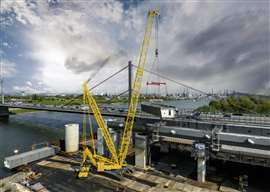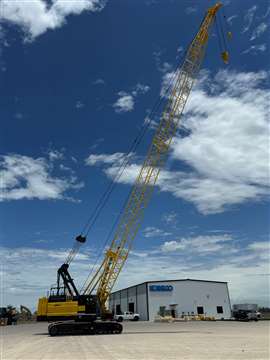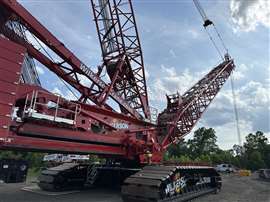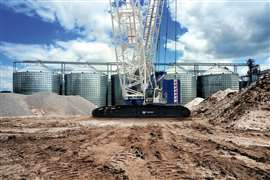The future of the lattice boom crawler market
15 July 2024
The market for lattice boom crawler cranes is strong and skittish. How can it be both?
According to executives with the major lattice boom crawler manufacturers, the market is facing a lot of challenges, although there’s plenty of work and large projects on the horizon. Crane companies report healthy backlogs and a steady influx of customers calling for quotes.
 Liebherr LR 1700-1.0
Liebherr LR 1700-1.0
Some contend that the market is flat because it’s a presidential election year. National politics and the related rhetoric give crane buyers a reason to delay their purchases. It creates discord and a “let’s wait and see” environment.
“The current market is somewhat slower than the past few years, but based on customer feedback, we may have a strong finish to the year and an improvement in 2025,” said Jim Jatho, product manager for lattice boom crawlers at Liebherr USA. “The offshore wind market was thought to be the next big draw for crawler cranes, but has lagged behind expectations. People within this industry are cautiously optimistic that there will be a turnaround. Onshore wind has been slower than expected, but should return in the second half of this year.”
Fleet refresh
Jatho expects the market to get better over the next year because he thinks more large-scale projects will come to fruition.
For Liebherr USA, the 700-ton capacity LR 1700-1.0 is the crane of choice, Jatho said, “because it’s the perfect fit between our retired models, the LR 1600/2 and LR 1750, which combined for over 400 units sold worldwide. The 1700-1.0 is a strong machine for both wind and industrial use, and will likely be a top seller for many years to come. Large scale microchip plants have absorbed significant amounts of these cranes, and it looks like this market will not be slowing down anytime soon.”
The first Liebherr crawler was delivered in the U.S. in 1977, but Jatho said it was not until 1994 that Liebherr USA started selling crawlers in significant quantities in North America.
Conversely, Link-Belt has been a player in the lattice boom crawler market for more than a century. The company is celebrating its 150th anniversary this year.
Despite challenges like interest rates and tight financing, Brian Elkins, lattice boom crawler product manager at Link-Belt, said the market is growing, mainly due to the infrastructure bill and renewable energy projects.
“Crane rental fleets are being refreshed in response to the demands of modern technology and safety requirements,” he said. “The overall supply chain is improving, helping manufacturers deliver cranes in a more timely manner. But the crawler crane market faces several challenges, including economic uncertainty, supply chain disruptions and stricter regulatory compliance. As an OEM, we must progress with technological advancements and the strong market competition. Additionally, finding skilled labor to operate and maintain these advanced cranes can also be a challenge.”
 Link-Belt 348 Series 2
Link-Belt 348 Series 2
But for the most part, Link-Belt believes the market should remain stable over the next year. Elkins said Link-Belt’s range of crawler cranes has seen an increase in demand across the board.
“The demand for the new 218|V has been strong since its ConExpo 2023 launch, as its size offers great versatility on the jobsite and when moving,” Elkins said. “Our 200 to 300-ton capacities have been in high demand for the last several years, and our newest luffer design has positively impacted larger-model sales.”
The driving forces in the market are infrastructure, bridges, roads and renewable energy projects, he said.
“Customers are seeking crawler cranes that have a strong lifting capacity and reach combined with advanced maneuverability and reliability,” Elkins said. “Link-Belt Crane customers love the simplicity of our cranes’ self-assembly capabilities.”
A special market
Kobelco started selling crawler cranes in North America in 1992 with the delivery of a 55-ton CK 550.
“Currently, the market is strong and very competitive,” said Jack Fendrick, COO and vice president of Kobelco Construction Machinery USA. “The demand for the 110-ton, 200-ton and 275-ton cranes is very strong. We believe this market still has legs, but the presidential election will determine how long.”
 Kobelco CK1100G-3
Kobelco CK1100G-3
The crawler crane market is special because of the caliber of the people who work in this sector, Fendrick explained.
“It is the best industry in the construction world because most of our customers are self-made individuals,” he said. “They earned their position through hard work, sacrifice and grit. We love working with them.”
Reliability and support are the two most important things in deciding which lattice boom crawler to purchase, Fendrick said.
“Our customers simply want a partner who cares about their success,” he said.
General construction is the hottest market segment, according to Fendrick. He also pointed to a particular challenge for all OEMs – workforce development.
“Finding young talent with a hard work ethic is a constant challenge,” he said.
For the past 99 years, Manitowoc has been selling lattice boom crawler cranes, introducing its first model in 1925.
Like Fendrick, Kevin Blaney, vice president of crawlers at Manitowoc, terms the market as “very good overall.”
“In my 20 years at Manitowoc, there have been periods of both strong and slow market conditions,” he said. “Currently, the market is as good as I can remember. What’s unique is the long-term optimism among people. In the past, confidence extended only six or 12 months into the future, but now people are talking about years instead of months. This is the first time I’ve experienced this kind of situation.”
The 300-ton-size class has become the crane industry workhorse, Blaney said.
 Manitowoc MLC300
Manitowoc MLC300
“The M-250, a 250-ton crane, was introduced in 1992, and at that time, people thought it was a huge crane,” he said. “However, over time, the 300-ton crane has become the norm. Anything from 275 to 350 tons is now considered the workhorse size, and it can be used for just about any project. Previously, cranes of this size were only purchased for specific jobs, but now they have become a standard part of many crane fleets. When customers are given larger tools, they will find new ways to use them, and that’s exactly what has happened with these cranes.”
Long-term optimism
Long-term optimism is being driven by so many megaprojects, Blaney said.
“Apart from the traditional everyday work, there are so many big megaprojects, such as chip manufacturing facilities, semiconductor and lithium plants and LNG plants that are either going on or proceeding in the near future,” he said. “That’s what’s consuming a lot of work and feeding long-term optimism.”
Blaney said cranes below 250 tons capacity need to be simple, reliable, easy to transport and competitively priced.
“Above 300 tons, features like the Variable Position Counterweight (VPC) technology set our cranes apart from the competition,” he said.
‘Fit and finish’
Tadano America’s Allen Kadow characterizes the market as “pretty level but not great.”
Kadow cited the election year as problematic and the main reason for the flat market. Although Tadano still fields “a decent number of quotes,” things won’t be better until after the election, he said.
Tadano has been in the lattice boom crawler market since 2019 when the company acquired the Demag brand from Terex. The biggest challenge for Tadano is that it only makes lattice boom crawlers in the higher tonnages.
 Tadano CC 24.400-1
Tadano CC 24.400-1
“We just do big cranes, 400-ton capacity and up,” he said. “Sales of these cranes are truly project driven. For now, the 400 to 700-ton segment of the market isn’t as big as the 250 to 300-ton class.”
Some rental houses have 700-ton cranes sitting in the yard, waiting for projects to kick off. “We just have to keep our ear to the ground and make sure we are getting in on every deal,” Kadow said.
The turn around for this segment of the market will likely take time, he said.
“We think it’s going to stay flat for a bit,” he said. “If interest rates come down and money becomes easier to get, then the bigger projects will ramp up again.”
All of Tadano’s lattice boom crawlers are built in its Zweibrücken, Germany factory.
“Right now, most of our quoting is for 400 and 650-ton cranes – those are the CC 24.400-1 and the CC 38.650-1,” Kadow said. “The wind market has gone a little flat, but there’s still a lot of work in petrochemical, tilt work, standard commercial structures, stadiums and infrastructure.”
In terms of what customers are looking for in a lattice boom crawler, Kadow said it’s “fit and finish. They need good quality machines that are reliable and have ready access to parts and service. You can line up six different 600-ton cranes, and they can all do the job. But good quality and reliability, plus parts and service access are what customers are looking for in the end.”
Kadow does see a bright spot ahead for larger crawlers, in the sustainable energy sector, but not necessarily wind.
“There’s a big drive for solar and battery technology,” he said, “especially battery technology. Batteries work when the wind isn’t blowing and the sun isn’t shining.”
Another trend Kadow sees is that cranes are lasting longer because of better technology and more preventive maintenance.
Assets lasting longer
“Owners are keeping their machines in better shape for longer,” he said. “Back when cash was at 0 percent, it was easy to buy a new crane. Today, owners are making their assets last longer.”
 Sany America SCA2600A
Sany America SCA2600A
Sany America is seeing increased demand in the 300-ton and above market, according to Joel Hicks, product manager.
“Customers want to be able to use one crane for multiple projects to conserve transportation costs and maintain space requirements,” he said. “Pre-cast construction and infrastructure work are ramping up while oil work is slowing down. Customers are extending the life of older machines while delaying the purchase of new machines due high interest rates and tight financing. Project delays and political uncertainty also factor into the equation.”
The latest generation of Sany crawler cranes were introduced to the North American market in 2021. The 300-ton SCA2600A is Sany’s most popular crawler model, Hicks said.
“Value, after-market support, job versatility and quality are most important to Sany customers,” Hicks said.





